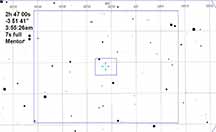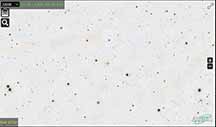



DAMIT shape model and the DAMIT repository shows two different shape models
OWc page, puts the northern limit on MIRA but also a tighter confidence (deserved? I'm not at all sure, given my experience of OWc maps)
This is a high value Trojan Asteroid, at decent 39 degree altitude (at MIRA), and 6.7s duration. The target is faint, but the moon is only 39%- and far away, and the centerline is predicted to cross MIRA, with 52% odds of a "hit" there. Also worth trying for Karl at home, with odds 39% but very valuable if a miss too. Will need long integrations under clear skies he should be able to get it. Integrations with the Watec 910hx can go as high as 4s, but I would not go beyond 2s to get a decent chance at a detection positive.
The mag drop is from 14.85 to 15.5 in G (0.7 mag drop), and uncertain drop in R (target star brighter at =15.1) because Mentor doesn't list R magnitude in OWc.
The target is in Cetus, just left of Mira.
From Santa Cruz: Alt=38, Az=226
Coordinates (on date)
RA=2h 47' 00.2s
Dec= -3 51 41"
 |
 |
 |
 |
Dan Cotton at MIRA contacted me 5 days prior, and we were now "on" for our night on the Ridge. Two students who'd expressed interest were not apparently available, but Sandy Astone is another planned future astronomer and he was eager to join us. There wasn't enough time to pull together another OccBox, and Karl was back East for a planetarium conference and his gear wasn't available either. There was tentative thoughts of placing someone at the 14" Observatory in Marina, and I discussed with Sandy. But, he was untrained, and so was the MIRA person who would be there, and there was no time to remedy that. Also, my thinking was that the latest predictions had Marina well north of the limit and a likely miss, and also that we may get such a short event at Chews Ridge that we will want to confirm each other's suspected positive, so I wanted Kirk and I both at Chews Ridge. Sandy would join us too, as he was interested in a possible summer '25 internship at MIRA.
Weather was to be iffy, with a cloud bank coming in that night. But as the week progressed, the latest forecasts said the clouds would hold off till 7am; 3 hours after the event, and skies would be clear for us.
We left Santa Cruz at 3pm Thursday, got to Carmel by 4:30, stopped for a couple of Subway foot-longs to get us fed for the all nighter, and arrived at the mountain top at sunset. Sandy caught up with us and we arrived together. After settling in, we did some twilight photography including Comet T-Atlas, and then began our prep for the asteroid event which would happen at 3:55am. The target star actually was high enough to access by 9pm and I decided that we would do our target ID, focusing and other calibrations on the target itself early in the evening. As it turned out, we needed much more time than expected to get fully ready. The target was expected to be as bright as the asteroid, and I assumed to be pretty close to it, like a binary star, in the evening. This was not the case. The R magnitudes were NOT the same, and unlike in our 8SE scopes, it was easy to underestimate how far Mentor would travel before hitting the target. I counted on the 14" scope to have a wide enough field of view in the sparse star area, to ID the target. But it took some time to do so. The target star was eventually ID'd but seemed much too faint, and the asteroid nearby was not to be found. It was brighter and farther away from the target than anticipated, but by checking the sky plane velocity in OWc and doing a little math, we did ID the asteroid. For the 36", even with the 0.5x focal reducer, the field of view would be only barely more than 1 arc minute and there were no suitable comparison stars in the area of the target. When the asteroid and target finally merged just before the event, it was clear that I could go with 8x for recording. Kirk at 16x on the smaller 14" scope. We both disconnected our monitors for the event, and got good recordings.
Sandy Astone (Astro 9A) joined us, driving up the long road from Santa Cruz in his own vehicle. He helped assist in some star chart ID problems for Kirk, and for me on the 36", as the fields of view were quite small and the star field quite sparse. He was a keen observer and paid close attention to all that went on, eager to learn enough to be able to get observations with Cabrillo College gear eventually.
I have scene shots of the going's on here, but have not had time to work on posting them, alas. It was a great astronomy adventure to get good data, and our results are below...
I settled on 8x setting, and my field included only the target+asteroid and a much brighter star nearby. The bright nearby star would be saturated and unusable for a comparison star. There were no clouds, and Kirk confirmed by a long Nikon exposure of Cetus just after the event. darkened the sky by changing gamma from 0.70 up to 1.00. I also did a BPC (bad pixel correction) in the Watec before any recordings this night. Skies looked entirely clear, until after the event and dawn approached and then cloud began to be visible and rapidly turned to sheep-back clouds enlarging until the entire sky was cloudy by after sunrise. It does not look to have affected our occultation, luckily.
I used dynamic apertures on the target, since it was clearly oblong at the begin and end of the recording, and for consistency, also on the reference star. The sky "no-star" was a static circular aperture. PyOTE found the correct 8x setting from the data. I set the D and R intervals and it found the event to good confidence. The drop in brightness, relative to the sky, was 60% of normal (40% drop) or 0.55 magnitudes. The PyOTE numbers below always assume sky=0, but for IRE=0 cameras like mine, this is not the case and so true mag drop must be assessed against measured sky brightness.
Begin recording: 10:52:06 UT
End recording: 10:58:36 UT
magDrop report: percentDrop: 41.1 magDrop: 0.574 +/- 0.097 (0.95 ci)
DNR: 3.71
D time: [10:55:34.1498]
D: 0.6800 containment intervals: {+/- 0.0480} seconds
D: 0.9500 containment intervals: {+/- 0.1221} seconds
D: 0.9973 containment intervals: {+/- 0.2728} seconds
R time: [10:55:36.7097]
R: 0.6800 containment intervals: {+/- 0.0480} seconds
R: 0.9500 containment intervals: {+/- 0.1221} seconds
R: 0.9973 containment intervals: {+/- 0.2728} seconds
Duration (R - D): 2.5599 seconds
Duration: 0.6800 containment intervals: {+/- 0.0738} seconds
Duration: 0.9500 containment intervals: {+/- 0.1705} seconds
Duration: 0.9973 containment intervals: {+/- 0.3610} seconds
|
Target clearly shows Mentor and star partially resolved at beginning of recording interval |
Bright star at right on screen, had saturated (red) pixels in PyMovie, but most were not saturated. |
Target light curve in PyMovie |
and, zoomed in on event. Event was clearly later than predictions |
I did not use a reference calibration star, as using the bright star only resulted in optmum smoothing when smoothing was arbitrarily large. One bad time stamp, long after the event which is in the middle. |
|
Clear event of .55 magnitude depth |
Passes FP test easily. |
Me, with the 36" and Comet T-Atlas. |
LuckyStar data uploaded 11/02/24.
IOTA report 11/03/24
Since our occultations were only 2.5s vs 6.7s for a max duration, it's highly likely that at Marina the event would have been a miss, and much more likely a miss from Santa Cruz. So far, it looks like only Jerry Bardecker tried this, except for our MIRA team. He had a miss from far north of the path, near home in Nevada.
Kirk settled on 16x, gamma=1.0
I got a 2.1 sec. event on the 14" Planewave CDK at MIRA, x16 integration with 0.5x reducer, recorded for 6 min 36 sec. At first I tried static apertures in PyMovie, and in PyOTE smoothed on a tracking star, but it completely failed the false positive test, although there is a visually obvious event near the predicted time.
There is a one-integration spike in the middle of the event, and PyOTE chose a D-R on one side of the spike, whether I set the D and R manually, or gave it a min/max to find an event.
I then tried a dynamic aperture for the target in PyMovie, this time PyOTE found the event on both sides of the central spike and gave a 2.1 sec. duration, two seconds after the predicted time.
I have uploaded my data to the Lucky Star occultation portal.
magDrop report: percentDrop: 40.4 magDrop: 0.561 +/- 0.203 (0.95 ci)
DNR: 3.19
D time: [10:55:34.6338]
D: 0.6800 containment intervals: {+/- 0.1114} seconds
D: 0.9500 containment intervals: {+/- 0.3118} seconds
D: 0.9973 containment intervals: {+/- 0.8193} seconds
R time: [10:55:36.7692]
R: 0.6800 containment intervals: {+/- 0.1114} seconds
R: 0.9500 containment intervals: {+/- 0.3118} seconds
R: 0.9973 containment intervals: {+/- 0.8193} seconds
Duration (R - D): 2.1354 seconds
Duration: 0.6800 containment intervals: {+/- 0.1775} seconds
Duration: 0.9500 containment intervals: {+/- 0.4576} seconds
Duration: 0.9973 containment intervals: {+/- 0.9903} seconds
 |
 |
 |
 |
 |
 |
Interesting that our D and R timings are not as close together as you'd assume, given the good conditions, large aperture, and precision of the stated accuracies in PyOTE.